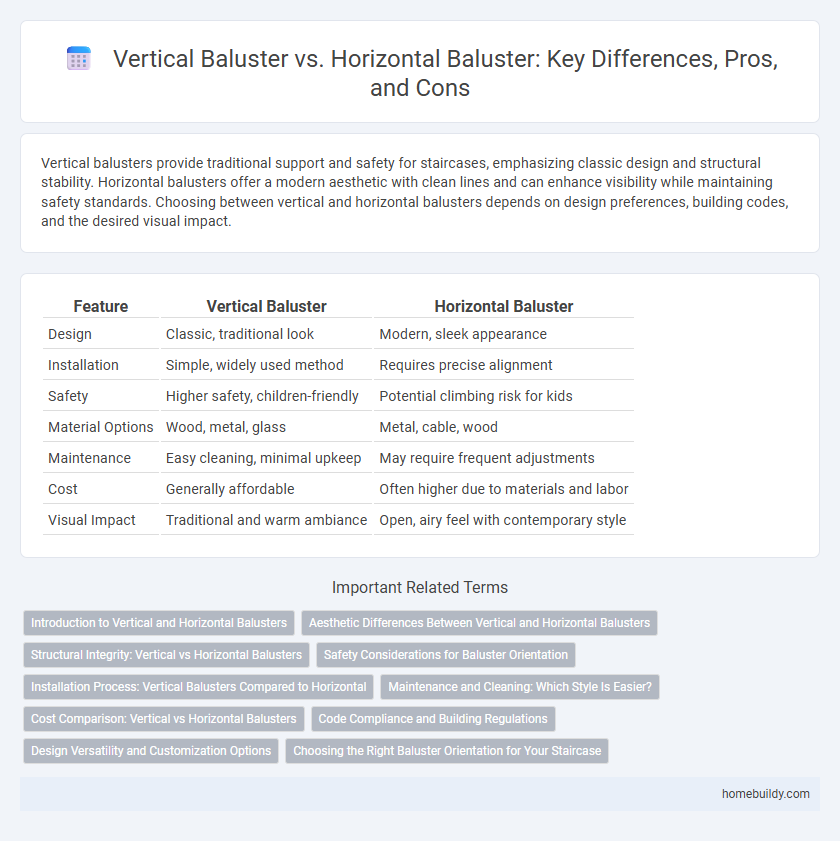Vertical balusters provide traditional support and safety for staircases, emphasizing classic design and structural stability. Horizontal balusters offer a modern aesthetic with clean lines and can enhance visibility while maintaining safety standards. Choosing between vertical and horizontal balusters depends on design preferences, building codes, and the desired visual impact.
Table of Comparison
| Feature | Vertical Baluster | Horizontal Baluster |
|---|---|---|
| Design | Classic, traditional look | Modern, sleek appearance |
| Installation | Simple, widely used method | Requires precise alignment |
| Safety | Higher safety, children-friendly | Potential climbing risk for kids |
| Material Options | Wood, metal, glass | Metal, cable, wood |
| Maintenance | Easy cleaning, minimal upkeep | May require frequent adjustments |
| Cost | Generally affordable | Often higher due to materials and labor |
| Visual Impact | Traditional and warm ambiance | Open, airy feel with contemporary style |
Introduction to Vertical and Horizontal Balusters
Vertical balusters, commonly used in traditional staircase designs, provide structural support and enhance safety by evenly spacing upright posts along the handrail. Horizontal balusters, often found in modern architectural styles, create a sleek, minimalist appearance by running parallel to the handrail and emphasizing clean lines. Choosing between vertical and horizontal balusters depends on aesthetic preferences, building codes, and the desired balance between functionality and visual appeal.
Aesthetic Differences Between Vertical and Horizontal Balusters
Vertical balusters create a classic and traditional aesthetic, offering a sense of height and openness that complements most stair designs. Horizontal balusters provide a modern, sleek look, emphasizing clean lines and a streamlined visual flow. The choice between vertical and horizontal balusters significantly impacts the overall style, with verticals enhancing elegance and horizontals promoting contemporary minimalism.
Structural Integrity: Vertical vs Horizontal Balusters
Vertical balusters provide superior structural integrity by evenly distributing weight and resisting lateral forces, ensuring stability in stair railings. Horizontal balusters can experience increased flex and require stronger materials or additional supports to maintain rigidity and safety. Proper installation and material selection are critical factors in enhancing the durability of either baluster type.
Safety Considerations for Baluster Orientation
Vertical balusters traditionally enhance safety by minimizing the risk of climbing, complying with building codes that limit spacing to prevent children from slipping through. Horizontal balusters may offer a modern aesthetic but pose greater safety concerns as their orientation can create footholds, increasing the likelihood of climbing accidents. Ensuring baluster spacing adheres to local safety regulations is critical regardless of orientation to prevent falls and enhance stairway security.
Installation Process: Vertical Balusters Compared to Horizontal
Vertical balusters typically require individual spacing measurement and alignment during installation, which ensures structural stability and uniformity in design. Horizontal balusters often involve pre-measured rail systems that simplify installation but demand precise leveling to maintain safety and aesthetic appeal. Choosing between vertical and horizontal balusters affects installation time and complexity, with vertical balusters generally requiring more detailed craftsmanship.
Maintenance and Cleaning: Which Style Is Easier?
Vertical balusters typically require less maintenance and are easier to clean due to their straight, uninterrupted lines that prevent dust accumulation. Horizontal balusters tend to collect more dust and grime on their surfaces, demanding more frequent and detailed cleaning efforts. Materials like wrought iron or powder-coated metal can further influence the maintenance ease for both vertical and horizontal styles.
Cost Comparison: Vertical vs Horizontal Balusters
Vertical balusters generally cost less due to simpler manufacturing and installation processes, making them a budget-friendly choice for staircases. Horizontal balusters can be more expensive because they require additional support and precise measurements to ensure stability and safety. Homeowners should weigh the initial cost difference against design preferences and long-term durability when choosing between vertical and horizontal balusters.
Code Compliance and Building Regulations
Vertical balusters typically meet stricter building codes and safety regulations by preventing children from climbing and ensuring spacing guidelines, usually no more than 4 inches apart, are adhered to. Horizontal balusters often require additional safety measures or restrictions to comply with building codes, especially in residential applications where climbing risks are higher. Ensuring compliance with local building regulations and International Residential Code (IRC) guidelines is critical when selecting baluster orientation for stair safety.
Design Versatility and Customization Options
Vertical balusters offer classic design versatility with a wide range of traditional to modern profiles, easily customizable through materials like wood, metal, or glass to suit diverse interior styles. Horizontal balusters provide a sleek, contemporary look appealing in minimalist or industrial settings, allowing customization through varied spacing, finishes, and integration with cable or rod systems. Both options support unique design expressions, but vertical balusters often align with more intricate detailing while horizontal balusters emphasize streamlined, open aesthetics.
Choosing the Right Baluster Orientation for Your Staircase
Vertical balusters provide a classic and timeless look, enhancing safety by preventing falls with their closer spacing and sturdy design. Horizontal balusters offer a modern aesthetic, creating an open and airy feel but require precise installation to meet building codes and maintain durability. Selecting the right baluster orientation depends on your staircase style, safety requirements, and the overall architectural theme of your space.
Vertical baluster vs Horizontal baluster Infographic

 homebuildy.com
homebuildy.com